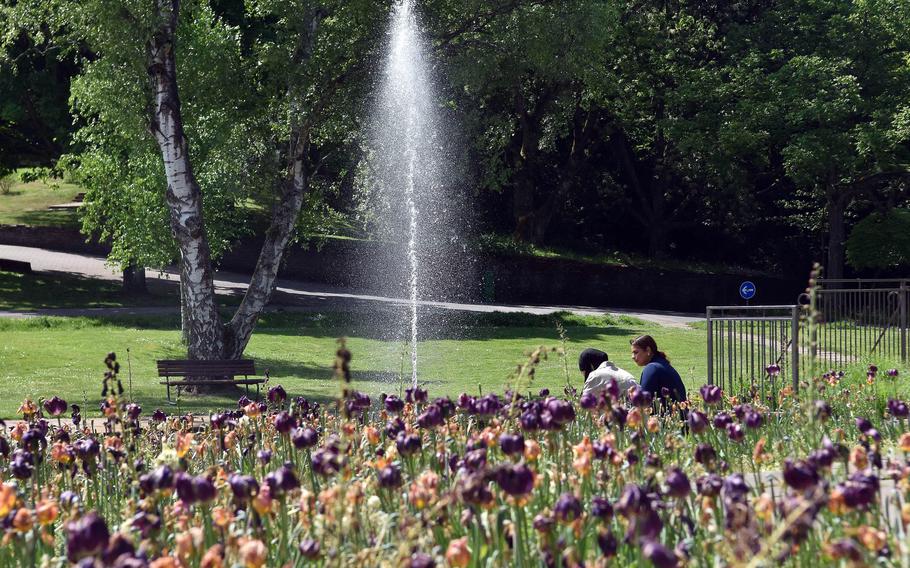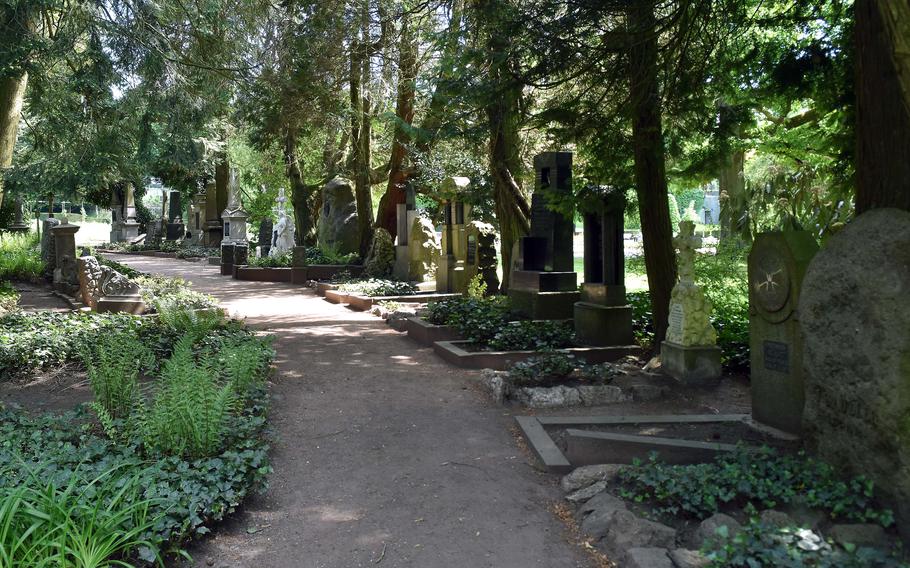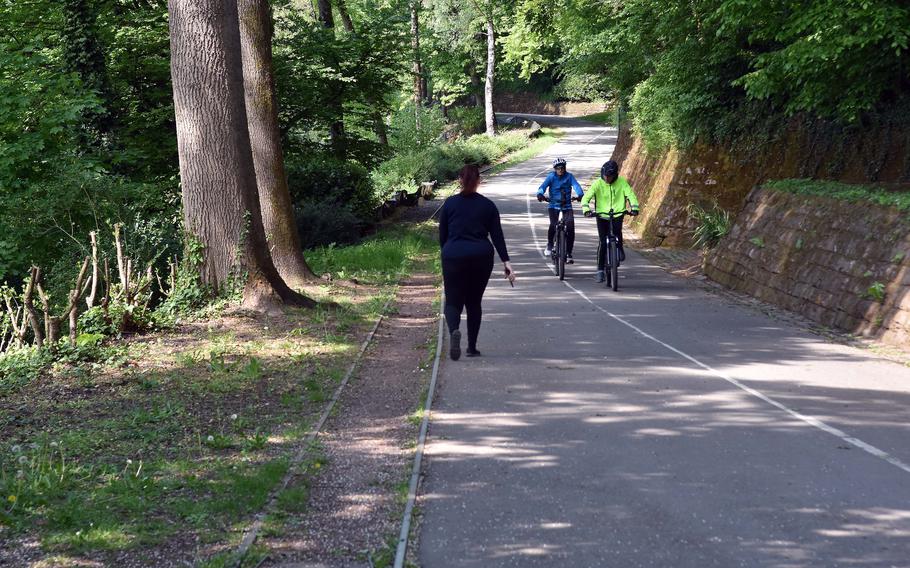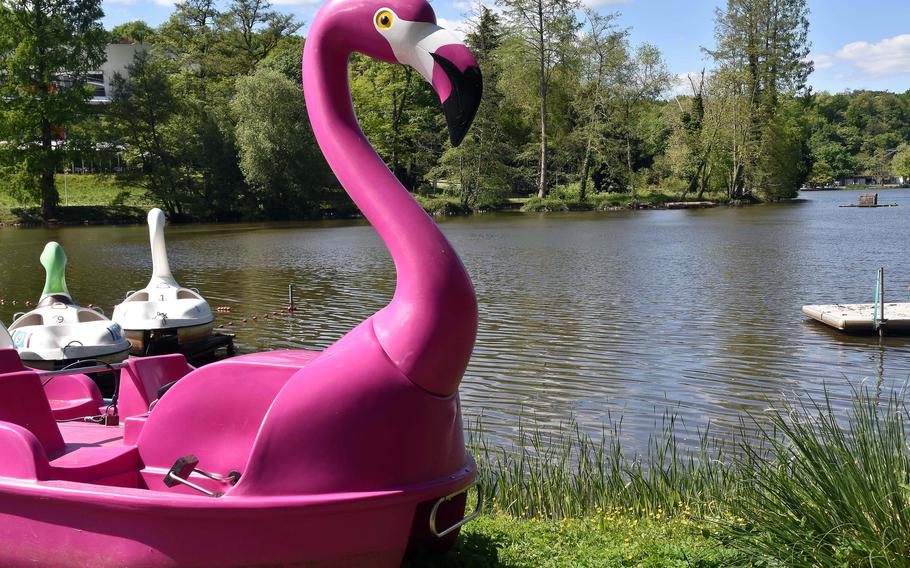
Visitors to the German-French Garden in Saarbrücken, Germany, enjoy some sunshine by a water fountain and a bed of tulips. The park is about a 45-minute drive from Kaiserslautern, close to the French border. (Jennifer H. Svan/Stars and Stripes)
Hitting 10,000 daily steps should be an easy feat at the German-French Garden, a sprawling public park on the outskirts of Saarbrücken with a bounty of trails, trees and geese.
The 123-acre site is near the French border, about 45 minutes away from Kaiserslautern. It’s best seen by foot, allowing one to meander through a grassy meadow, rest on a lakeside bench or stop and smell the roses in the park’s smaller terraced gardens.
If you have a few hours to spend and a good pair of shoes, you can learn a lot about the site’s different sections, such as the “Silver Maple” garden with its various flower beds, by walking around and reading the park signs, which are in German, English and French.

German and French military personnel and civilians who died on Aug. 6, 1870, in the Battle of Spichern are buried side by side in a cemetery at the German-French Garden in Saarbrücken, Germany. The burial ground there is one of Germany's oldest military cemeteries. (Jennifer H. Svan/Stars and Stripes)
The creation of the garden in 1960 was an attempt to reconcile the troubled history between the two European powers that played out on the border. It became a symbol of cooperation and friendship with both French and German gardeners contributing to the landscape design.
One joint project was to bury concrete anti-tank barriers under the “Valley of Flowers,” a meadow that blooms in early spring with daffodils, tulips and bluebells, before giving way to summer’s day lilies, irises and asters.
The largest green space in the Saarland capital wasn’t always such a peaceful oasis, as illustrated by a war memorial cemetery laid out under a shady grove of cypress and oak trees.

Remnants of the Westwall bunker, built during the late 1930s, can be seen at the German-French Garden in Saarbrücken, Germany. The garden is now a symbol of friendship between the two countries. (Jennifer H. Svan/Stars and Stripes)
The garden land was the site of a fierce battle during the 19th century Franco-Prussian War and part of the Third Reich’s 391-mile Westwall fortification of bunkers and anti-tank barriers during World War II.
Some of the war dead from the 1870 Spichern Heights campaign by Prussia in its war against France are laid to rest here in one of Germany’s oldest military cemeteries.
The towering trees framing the many paths throughout the park look old enough to have provided shade to 19th century soldiers.
But some of the facilities looked abandoned or run-down. Weeds grew on the brick patio of a ramshackle, empty restaurant that must have seen better days.

Designated paths for pedestrians and cyclists crisscross the German-French Garden in Saarbrücken, Germany. There are three main marked walking paths on varied terrain, while an asphalt cycling path connects the main and north entrances. (Jennifer H. Svan/Stars and Stripes)
A cable car that transports riders above the treetops looked closed. German news reports said it was supposed to open this spring, but calls to a number listed on the park’s website for the cable car operator went unanswered.
The station for the park’s light rail system was also shuttered, but the park website notes that a small trackless train runs throughout the park on Wednesday, Saturday, Sunday and public holidays, from 1 to 6 p.m.
Despite the dilapidated appearance in places, the garden was buzzing with hikers, cyclists, couples and families on a recent spring day. A playground with a water station and a shallow creek to wade in seemed especially popular with kids.

Pedal boats resembling waterfowl can be taken out on the largest lake at the German-French Garden in Saarbrücken, Germany. (Jennifer H. Svan/Stars and Stripes)
For walkers and runners, there are three sign-posted routes, including an asphalt trail with a bicycle lane that connects the park’s main and north entrances.
Several of the lakes and ponds have fountains, including one that puts on a rhythmic water show every hour in the summer timed to music. Pedal boats in the shape of geese and flamingos can be rented on certain days.
A few small restaurants and snack shops offer a place to replenish spent vigor and rest tired feet.
svan.jennifer@stripes.com @stripes.ktown

The German-French Garden in Saarbruecken, Germany, is an easy, 45-minute drive on the autobahn near the French border. (Jennifer H. Svan/Stars and Stripes)
Address: Deutschmühlental 4, Saarbrücken, Germany
Hours: Open 24 hours a day year-round
Cost: Free except for special events. Riding the small train that circles the park costs 3.50 euros round trip per person; paddle boats cost 3.50 euros per person for 30 minutes and 5.50 euros for one hour. A round of miniature golf costs 2.50 euros for children up to 12 years old and 3.50 euros for adults. Free parking is available outside the park’s north entrance.
Information: +49 681-905-2159, www.saarbruecken.de/dfg